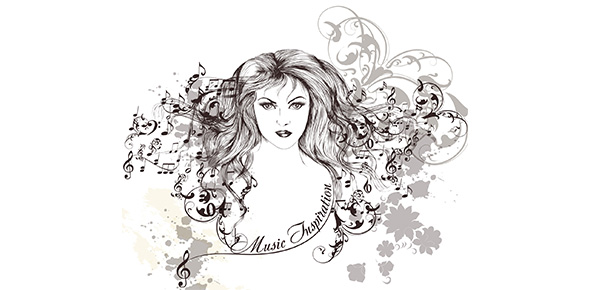Related Flashcards
Related Topics
Cards In This Set
| Front | Back |
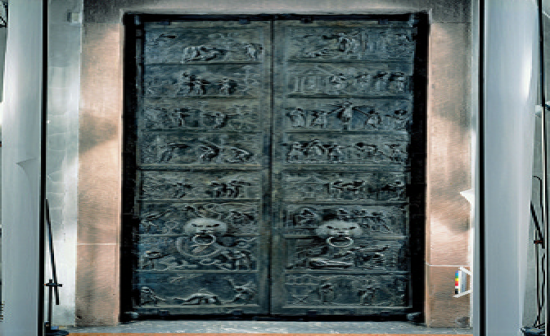 What is this image? |
Doors of Bishop Bernward, Hildesheim Cathedral, ca. 1015 CE
-bronze doors man who paid for these was the bishop of killdeshine, after he had been the court chaplin and a tutor of Otto III significant here that we identify art by the names of the arists, but often more important is the patron in this case the patron is the bishop thought up ideas for the doors, suggests there are different people who contribute to making a work of art, is a collaboration rather than one single work of genius on exterior of a church attached to a monastary, commisioned these doors to suggest wealth of the place, very large, have to melt enough bronze to make the bed for these doors, this is emulating ancient monuments, making things live again, the monks in this monastary were corrupt, one rule that all monks have is celebacy, but a lot of these monks had kids so bishop had these doors commisoned as a message for a need of greater virtue the doors juxtapose a story from hebrew scriptures with a story from christian scriptures, idea is that both jewish and christian history fit together and that history is not just a linear development, but a kind of a pattern, if you look from God's pov it would make a kind of a picture, |
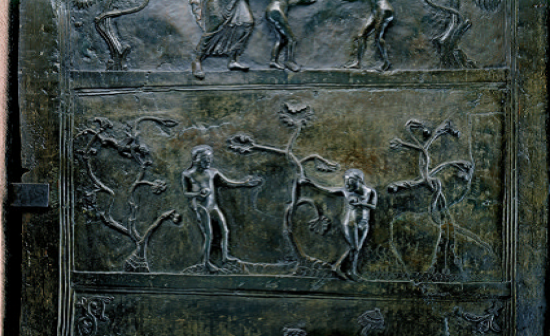 What is this image? |
The Temptation and Fall, Doors of Bishop Bernward, Hildesheim
Cathedral, ca. 1015 CE
- cast in bronze, classical idea, but the figures do not look classical the story here is when the first man and first woman are in garden of eden, eve seems to be plucking one fruit and is holding another, shes holding it in front of her breast, the temptation is sexual, the fruit is eve's body? instead of showing balance and confidence in the bodies, they are strong figures rather than the perfected man made in God's image |
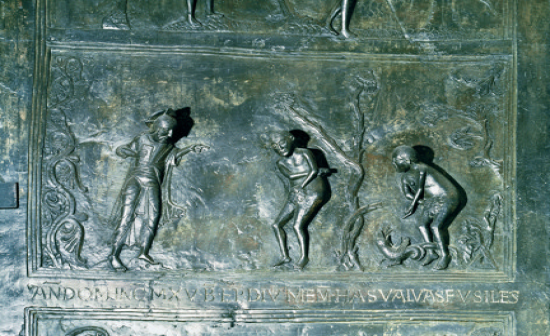 What is this image? |
Accusation and Judgment, Doors of Bishop Bernward, Hildesheim
Cathedral, ca. 1015 CE
- the one on left is not so much a classical figure, but with power and strong gesture, moment adam and eve realized theyre naked, they show shame, this emotional storytelling doesn't necessarily come from greater realism, we don't have a naturalistic setting instead from the schematic exaggerration that makes the forms seem more [pwerful it tells the story in a condensed way |
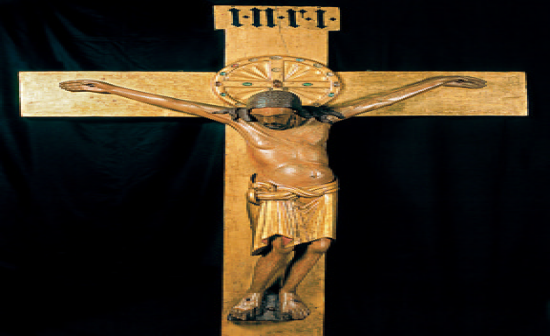 What is this image? |
Crucifix (known as the Gero Crucifix), ca. 970 CE,
- we begin to see an interest in showing the fragility of the human condition, get a sense of a physical body that had been nailed to the cross, can get a sense of life from the depiction of jesus on the lindau gospel, but here he appears near death this cross is over 6 feet tall would look up and get an overwhelming vision that even God suffers this fate, some believe that because he was God, his suffering was much greater than man's |
 What is this image? |
Church of San Vincenç, Cardona, Spain, ca. 1029-1040 CE
(compound piers)
- Very stripped down, originally sculptures, stained glass, would look like a junk shop of religious offerings - Stripped down due to modern tastes - Theres very little architectural ornament here, a semi dome in the apt, use of stone throughout, there are no columns, instead we see compound piers supporting the arches and supporting the domes, have ribs or strips attached to them, so go up and help support the barrel vault, typical in medival architecture, we are looking at something the signifies differently in architecture |
 What is this image? |
Portal of the Church of Saint-Pierre, Moissac, 1115-1130 CE
- This is the door that faces out to the public, that you enter through, if you look closer at it the central half circle space is called the tympanum, the space between two doors is the trumeau - The scene is the apocolapys in which jesus returns and he is enthroned, the figures here are of very different scales, get little sense of their bodies, God is this overwhelming prescene, - Basically says you must repent |
 What is this image? |
Trumeau, Portal of Saint-Pierre, Moissac, 1115-1130 CE
- See stylized lions, as you walk through the door and if you turn to the side and look up you can see the picture of a prophet, you can see that theyre showing this to you and thought about those who would come to the church, would see this figure twisted looking down at them and it would be a terrifying thing |
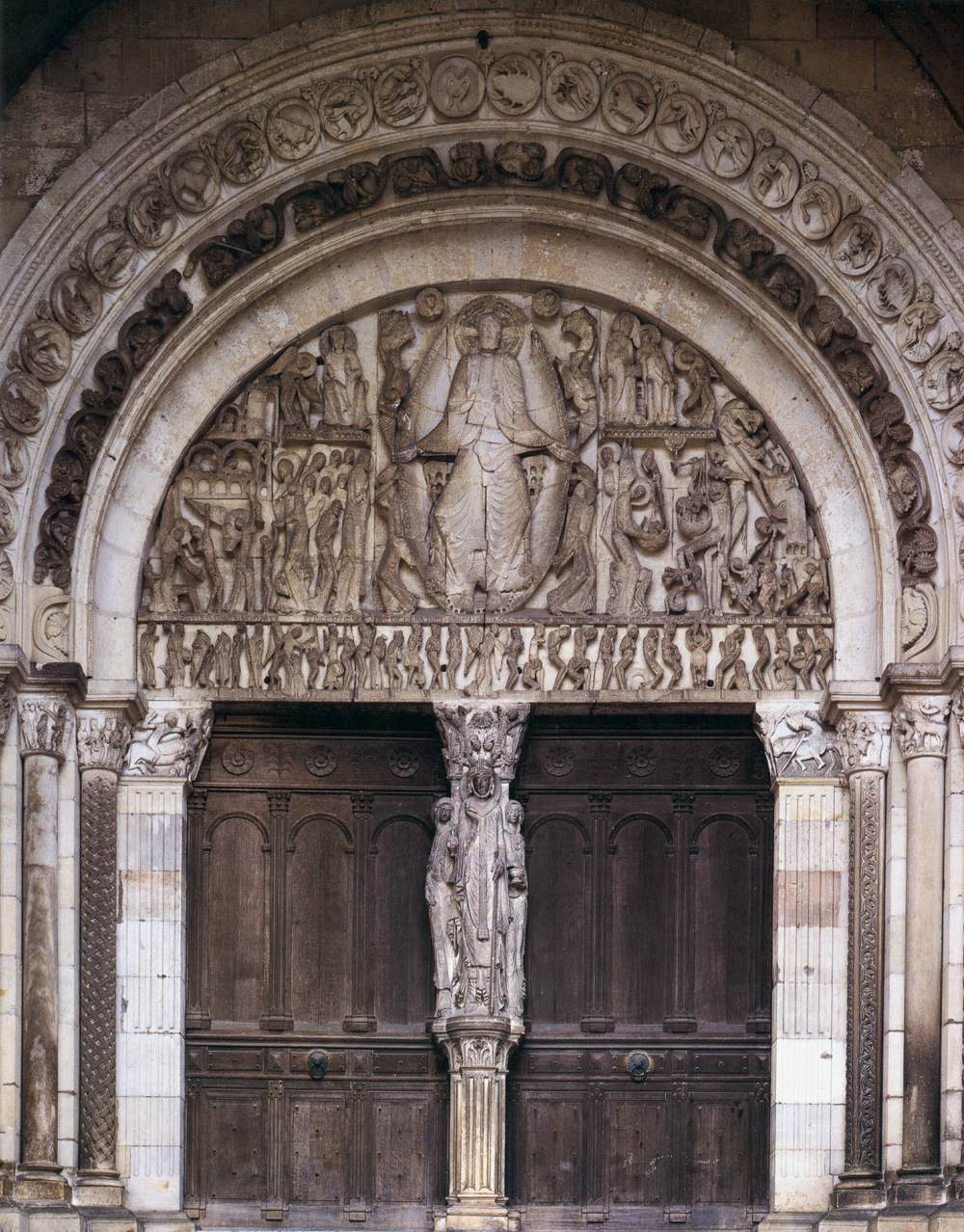 What is this image? |
Gislebertus, Last Judgment, West Portal, Saint-Lazare, Autun,
ca. 1120-1135 CE
- This is the artist, gislebertus, he signed it - Can see the end of days, but here we see the last judgement, souls that are saved on the left, see the weighing of the souls on the right, - Here different styles are used for different figures to make this explicit, God is huge, magnificent, etc. - The others are small spindly, - If you look at devil on the last judgement you can get a sense of the terror its meant to insite - Here is the damned with enormous hands coming to grasp around his head, this illuminates the saldjaslk |
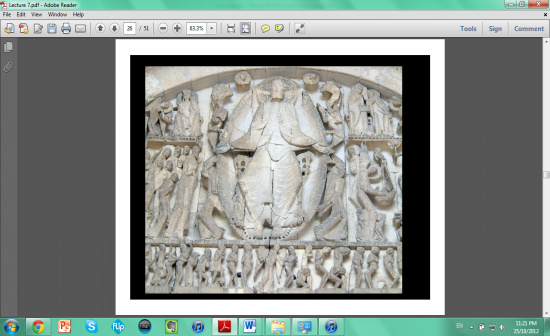 What is this image? |
Gislebertus, Last Judgment, West Portal, Saint-Lazare, Autun,
ca. 1120-1135 CE
|
 What is this image? |
Cloister, Priory of Saint-Pierre, Moissac, ca. 1100 CE
- Here is the part where only the monks have access, inside the private part of the monastery, open in the center for light and air, place for reading and meditation - These are places for reading, meditation, for monks, they’re ornately decorated, there are ornate columns, some have intertwined birds, have monsters, biblical stories, - St Bernard of claivous, was frusterated with this kind of art, with the ornate decorations, why have these monsterous figures? Why have these for the monks? |
 What is this image? |
Nave, Abbey Church, Fontenay, 1139-47 CE
- This was never painted, had no stained glass, gold statues, built to be a kind of new restrained style that was supposed to focus your meditations and get back to “truer” Christianity |
 What is this image? |
Initial I, from Gregory the Great’s Moralia in Job, 1111 CE
- Don’t see any gold or blue, why have a picture at all? This I is made from monks cutting down a tree, working hard, at the same time, theres a potential for distraction, not totally focused on the text, |
.jpg) What is this image? |
Ambulatory, choir of the Royal Abbey Church of Saint Denis, France 1140-44
Abbott Suger The ambulatory is the passageway that goes around the main apses in a church Enormously important church politically and religiously in france at this time Monks used this as their church, Benedictine monastery Where the kings of france were buried Also a shrine and contained the relics of sandonine, the patron saint and protector of france We see religious functions and political functions inexplicably combined Sought to gain control of a larger area (the French) Reconstructed by abott sugar The projecting absidioles (or nubs) the space has been opened up so it is not clear when you’re in a separate chapel, etc. Separated by columns, light streams in through enormous stained glass windows, not blocked by any side walls, get a very new sense of light and openness as you walk through this choir The abott runs the monestary, patron of this place, every detail in the construction of the project, he wrote about it and tells us how he had it ornamented in stained glass, sculptures, jewels, chalices made of gold encrusted with rich jewels, and describes how this should make us feel |
 What is this image? |
West façade of the Cathedral of Notre-Dame, Chartres, France, ca. 1145-1220 (left spire is 16th C.)
Period with enormous devotion to the virgin, the virgin was idolized, very little attention towards Christ None of these churches are dedicated to jesus, but dedicated to his mother Held the clothes she was thought to have worn when jesus was born, Most Christians believe that mary rose physically to heaven, Her clothes is a very important historic relic Not symmetrical, built over the centuries Symmetry is not as important here as it is in classical architecture, no sign of the orders, instead of columns that give us sense of proportion of the human body, we have emphasis on ascent, instead of articulating the structure and making it clear how it is held up, we have huge windows so that they look light and immaterial |
 What is this image? |
Jamb statues (Prophets, Kings, and Queens), west portal of Chartes, ca. 1145-50
Christian churches are oriented towards the east, direction of rising sun, west side is the principle entrance This is the central door in that west façade Statues of kings and queens who were thought to have prophesized the coming of Christ, politics is part of the mx here, important for religious devotion Under royal patronage, royal lineage of kings and queens, suggests connection between the divine and rule on earth Not classical, modern style, the forms have no attempt to show a moving body, statues are lined up against the columns and the feet don’t stand flat and have been given little platforms, this is about an eternal prescence, something stable |



